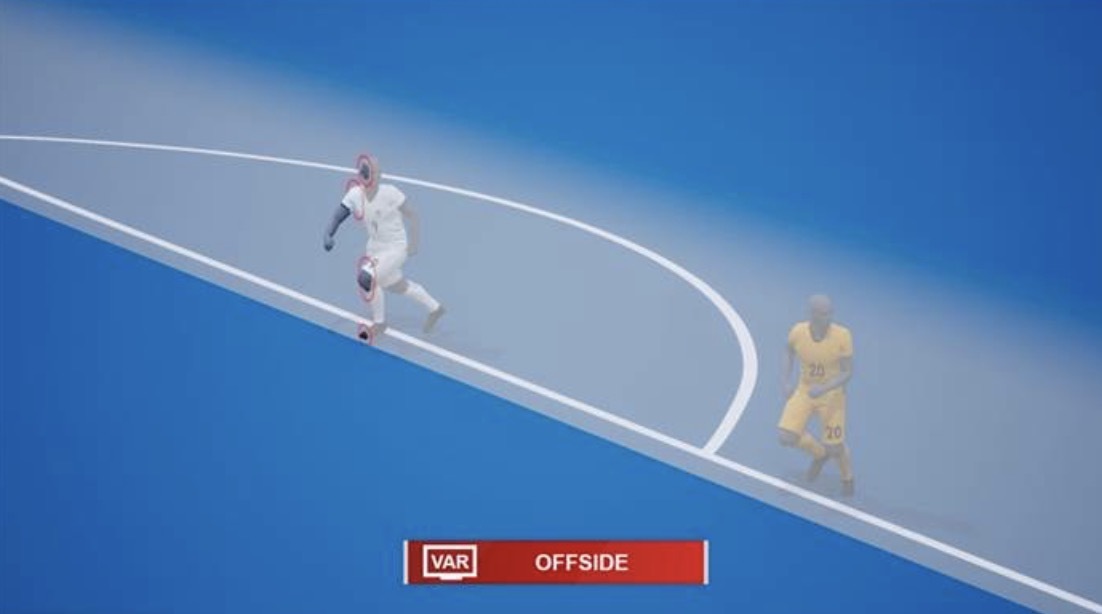FIFA's new offside technology to make World Cup debut in Qatar
By YonhapPublished : July 1, 2022 - 19:42

FIFA announced Friday it will implement a new offside technology at this year's World Cup to help video match officials and on-field referees make faster and more accurate decisions.
Following a series of successful tests, FIFA's semiautomated offside technology (SAOT) will make its World Cup debut in Qatar in November.
The SAOT, which was tested at the 2021 FIFA Club World Cup and 2021 FIFA Arab Cup, is an extension of the video assistant referee (VAR) system, currently in use at all FIFA competitions. FIFA said 12 dedicated tracking cameras will be mounted at stadiums to track the ball and 29 data points on each individual player, 50 times per second. These data points include all limbs and extremities relevant for making offside calls.
The official ball in Qatar, Al Rihla, will be equipped with an inertial measurement unit (IMU) sensor, which will send ball data to the video operation room 500 times per second.
For offside situations, kick points and positions of players' limbs will be relayed to the VAR in real-time, with the use of artificial intelligence.
Before informing the on-field referee, the video officials will manually check kick point and offside line, both automatically generated.
Once the call is made, the exact same positional data points provided to officials will be generated into a 3D animation, featuring details on the position of the players' limbs at the moment the ball was played. This 3D animation will be displayed on the stadium scoreboard and will also be made available for television viewers.
"Our goal is to help the referees take the decision correctly on the field of play," said Pierluigi Collina, chairman of the FIFA Referees Committee, during an online media briefing on the SAOT on Thursday. "If something wrong should happen, we are ready to provide the referee with technological support to avoid mistakes that may affect the outcome of the match."
Johannes Holzmuller, director of Football Technology and Innovation at FIFA, said he was "very confident" that all possible offside scenarios can be covered by the SAOT.
"The SAOT can be used whenever the ball is received by an attacker who was in an offside position at the moment the ball was played by a teammate," he said.
According to both Collina and Holzmuller, VAR decisions on offsides take 70 seconds on average, but the SAOT will cut that time down to 20 to 25 seconds.
Collina, who worked the 2002 World Cup final, also said there is still room for referees' discretion and judgment despite ever-improving technology in football officiating.
"Although we have implemented technological support, referees remain the final decision makers. They are responsible for final decisions," the Italian ex-referee said.
"We want to have an accurate and fast decision. But this (SAOT system) is only for positional offside. The interpretation and assessment of interfering with an opponent, to see if a foul was committed, remain at the discretion of the referee. The referee may take advantage of the support of technology to get better vision of what happened on the field of play." (Yonhap)






![[KH Explains] How should Korea adjust its trade defenses against Chinese EVs?](http://res.heraldm.com/phpwas/restmb_idxmake.php?idx=644&simg=/content/image/2024/04/15/20240415050562_0.jpg&u=20240415144419)












![[Today’s K-pop] Stray Kids to return soon: report](http://res.heraldm.com/phpwas/restmb_idxmake.php?idx=642&simg=/content/image/2024/04/16/20240416050713_0.jpg&u=)